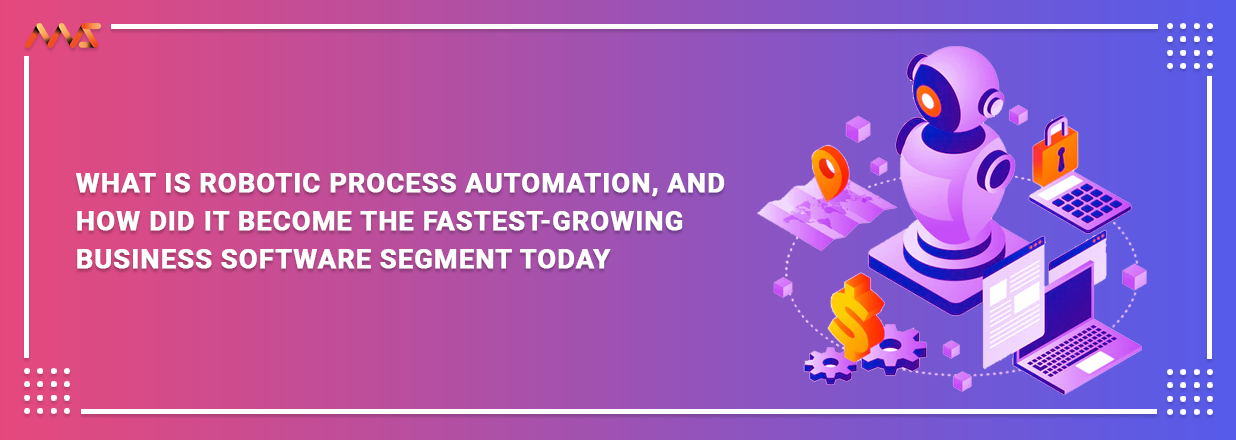Robotic Process Automation (RPA) envisions a future in which software robots would handle all the boring, repetitive jobs that people detest, freeing us up to engage in leisure activities with friends and family. How? This blog will discuss the development of this technology and its up-to-date effects on our planet.
The development of computer macros was initially created to increase the efficiency of operations. NET-based programming marked the beginning of enterprise automation. But in the early 2000s, a new wave of technologies known as RPA emerged as a task-based automation tool riding on the shoulders of screen scraping and workflow automation technologies, driven by the 4th Industrial Revolution and digital transformation. It made it possible for business users without coding expertise to use straightforward drag-and-drop and out-of-the-box automation, like data scraping, and carry them out quickly without the assistance of the IT team.
Described RPA's value
Unlike any other enterprise software category we've seen before, robotic process automation has had a skyrocketing adoption rate. This may be attributed to its overabundance of advantages for contemporary businesses. Integrating data without using any APIs can reduce expenses, get rid of keying errors, speed up procedures, and revive legacy applications.
One of RPA's most attractive features is its capacity to streamline data integration from legacy systems, significantly advancing an organization's digital transformation goals by releasing the value of prior investments. Without the need for disruptive and expensive integrations, RPA enables an organization to easily integrate and automate interactions between several systems. A software robot, for instance, can retrieve an MS Excel file from an email, extract the precise information that must be entered into a cloud-based CRM, and then insert the same information into an on-premise ERP platform.
Also Read -: Everything You Need To Know About CRM For Small Business
The low entry barriers it holds are another advantage of RPA that has helped its tremendous development. Whether in IT, Finance, or HR, organizations don't need a significant IT budget to apply automation in a given process. Enterprise-level organizations first used RPA, but small and medium-sized firms were as quick to join the automation revolution.
According to the research, approximately 97% of firms believe automation enables digital transformation.
Models Types Of Robotic Process Automation
Attendant
acts as a virtual personal assistant that collaborates with staff to streamline their routine tasks. Automated procedures need human involvement to be carried out.
Unattended
possesses intelligence and some independent decision-making skills. It adheres to a rules-based approach to accomplish tasks like complex data processing, data management duties, or even finishing back-office tasks. These bots normally run on a predetermined timetable without human input.
Hybrid
Both attended, and unsupervised capabilities are combined in it. A team of software bots and people will transmit jobs back and forth to optimize operations. It is frequently hailed as the most successful form of automation.
How Does Work RPA function?
RPA's appeal is due in part to its ability to mimic how humans carry out computer-based processes, as opposed to automation techniques like application programming interfaces (APIs) or low-code development that are more scalable and highly user-friendly or demand specialised knowledge.
Some Significant RPA Benefits
- Increase ROI and accelerate the benefits of digital transformation.
- Increase operational effectiveness while cutting expenses.
- Reduce instances of data accuracy problems and keying errors.
- Utilize data, documentation, and lean workflows to improve bottleneck operations.
- Enhance the precision and speed of business processes,
- Enhanced client satisfaction, and increased employee satisfaction
- Ensure audit trails, and lower risk and expense associated with compliance.
- Boost record digitization and legacy integration.
- Enabling data-driven decision-making and the development of cognitive technologies.
RPA's Business Benefits
The benefits of RPA are numerous and comprehensive. Using processing speed, accuracy, and cost-effectiveness enables bots to achieve significant and measurable increases in customer satisfaction and employee engagement.
Decreases Costs
RPA provides a quick and considerable drop in investment costs. Even if there are up-front expenses like app purchases, installation, upkeep, and upgrades, controlling a software robot is far less expensive in the long term than hiring and paying for full-time employees. It also involves the same amount of work.
Boosts Productivity
When compared to humans, software robots can complete the same mundane activities far more quickly. When given the correct instructions, an RPA bot could likely complete a task that would take an individual four hours to complete in just a few minutes.
Conclusion
The rapid and efficient nature of robotic process automation, a cutting-edge technology solution, interrupts the digital transition.
The rapid and efficient nature of robotic process automation, a cutting-edge technology solution, interrupts the digital transition. Processes are accelerated, better customer experiences are provided, corporate operations are streamlined, and human resource productivity is increased. This technology is for you if your business depends on quick and effective procedures to boost performance and give customers better experiences.


